Belarus Tour Guide: Ideas for Your Trip!
What to see in Mogilev: Landmarks in the city over the Dnieper
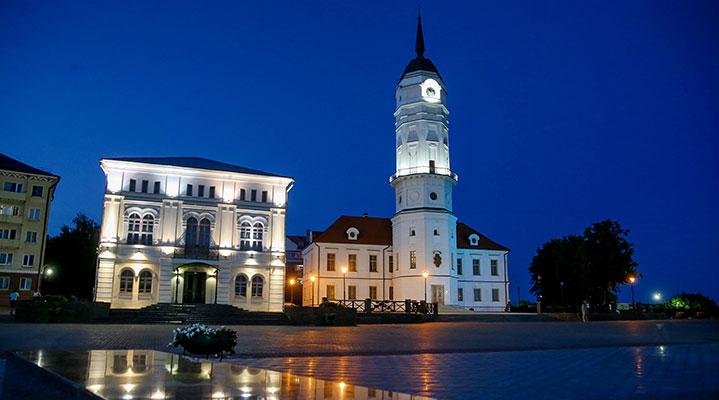
The city on the banks of the Dnieper River, which received the mysterious name of Mogilev, holds a special place in the history of Belarus. Centuries ago it was a border fortress, a land of honorable dynasties, a major trading hub of the Grand Duchy of Lithuania, a gubernatorial center. During the First World War it hosted the Supreme Commander's HQ (stavka) and the residence of Emperor Nicholas II. In the run-up to the Second World War, Mogilev nearly became the capital of Belarus. As Minsk was in a dangerous proximity to the western border, the government decided to re-locate to Mogilev. Within a record short time, almost an exact replica of the House of Government in Minsk was built in the center of Mogilev. Yet the relocation never happened. The heroic defense of Mogilev at the start of the Great Patriotic War is one of the most glorious pages in the country’s history. The city courageously held ground for 23 days, being fully encircled during 16 days...
Having visited Mogilev at the end of the 19th century, famous Belarusian ethnographer, archaeologist and public figure Ivan Lutskevich called it “a little Prague”. The city had a lot of beautiful historical buildings constructed during the times of the Russian Empire. There were many religious buildings: 26 Orthodox churches, 6 Catholic churches, several dozen synagogues, a church...Unfortunately, after the Second World War much of the heritage was lost. Mogilev carefully preserves the surviving historical monuments and also creates new tourist attractions. The ancient city, which turned 750 in 2017, has a lot to offer to visitors!
Mogilev Lions
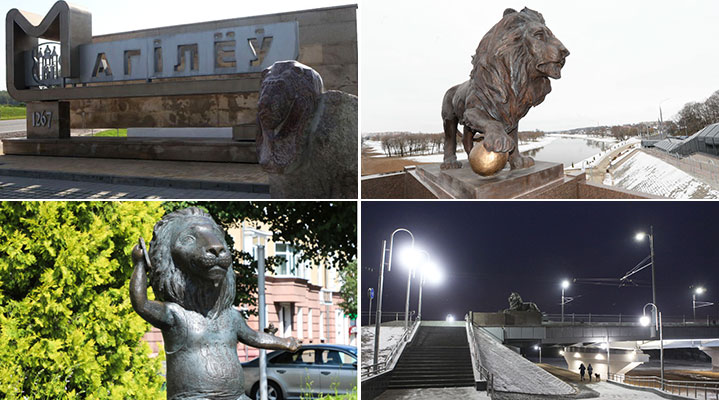 The origins of the name “Mogilev” are still unknown. There are several theories and legends. The most romantic one tells about a noble villain Masheka nicknamed Lev (Lion) who defended the poor and disadvantaged. He died at the hands of his beloved one who became the wife of a treacherous rich man. A mound was made on the tomb of Lev the Lion. That was where the city began… Another version is associated with the name Mogila though historians have not yet found the traces of such a personality in the history of the city. Another theory claims that the name comes from Galicia–Volhynia Prince Lev Danilovich Mogiya (mighty lion). He supposedly ordered the construction of Mogilev Castle in 1267. However, the fact has not been confirmed scientifically. A number of researchers suggest the Finno-Ugrian word “mogilyai” which means a mountain above the water. Also, a curious version was found in the ancient Mogilev chronicle which mentions a combination of words “Mogy Lev” (mighty lion) but not as a description of a particular person but of a city that like a mighty lion resists wars, disasters and adversity ... In any case, many versions refer to the lion, and nowadays it has become a symbol of the city. Residents and visitors to Mogilev are greeted by sculptures of lions in various places: a granite lion at the entrance to the city, and four bronze lions - on the bridge over the Dnieper, the popular "Leo from Mogilev” in Mironova Street near the Spartak stadium.
The origins of the name “Mogilev” are still unknown. There are several theories and legends. The most romantic one tells about a noble villain Masheka nicknamed Lev (Lion) who defended the poor and disadvantaged. He died at the hands of his beloved one who became the wife of a treacherous rich man. A mound was made on the tomb of Lev the Lion. That was where the city began… Another version is associated with the name Mogila though historians have not yet found the traces of such a personality in the history of the city. Another theory claims that the name comes from Galicia–Volhynia Prince Lev Danilovich Mogiya (mighty lion). He supposedly ordered the construction of Mogilev Castle in 1267. However, the fact has not been confirmed scientifically. A number of researchers suggest the Finno-Ugrian word “mogilyai” which means a mountain above the water. Also, a curious version was found in the ancient Mogilev chronicle which mentions a combination of words “Mogy Lev” (mighty lion) but not as a description of a particular person but of a city that like a mighty lion resists wars, disasters and adversity ... In any case, many versions refer to the lion, and nowadays it has become a symbol of the city. Residents and visitors to Mogilev are greeted by sculptures of lions in various places: a granite lion at the entrance to the city, and four bronze lions - on the bridge over the Dnieper, the popular "Leo from Mogilev” in Mironova Street near the Spartak stadium.
Mogilev railway station from the tsarist era
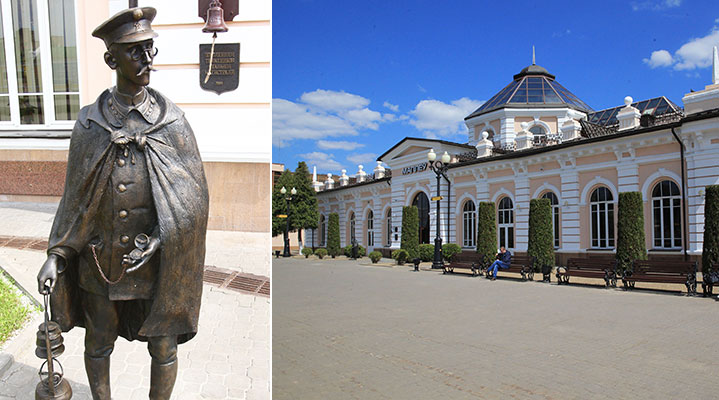 The building of the Mogilev railway station was built in 1902 in the Neoclassicism style. It was one of the most beautiful and comfortable stations of that time. It was fitted to accommodate government delegations. Initially, people used cabbies to get to the railway station. A taxi service became available in the city in 1911. It was owned by Samuel Chagall, a relative of the world-famous artist Marc Chagall. The famous poet Sergei Yesenin also had a relation to the Mogilev railway station: in 1914-1915 he served there as a military paramedic... After the war, the station underwent many restorations but retained the historical looks: semicircular windows and pilasters, an octagonal lobby, and a glass roof.
The building of the Mogilev railway station was built in 1902 in the Neoclassicism style. It was one of the most beautiful and comfortable stations of that time. It was fitted to accommodate government delegations. Initially, people used cabbies to get to the railway station. A taxi service became available in the city in 1911. It was owned by Samuel Chagall, a relative of the world-famous artist Marc Chagall. The famous poet Sergei Yesenin also had a relation to the Mogilev railway station: in 1914-1915 he served there as a military paramedic... After the war, the station underwent many restorations but retained the historical looks: semicircular windows and pilasters, an octagonal lobby, and a glass roof.
Near the railway station there is a sculpture of a station caretaker in a cap with a cockade, a watch on a chain and a lantern. That was how the main station caretaker looked like in the times of the Russian Empire.
Triumphal Arch at the entrance to Mogilev
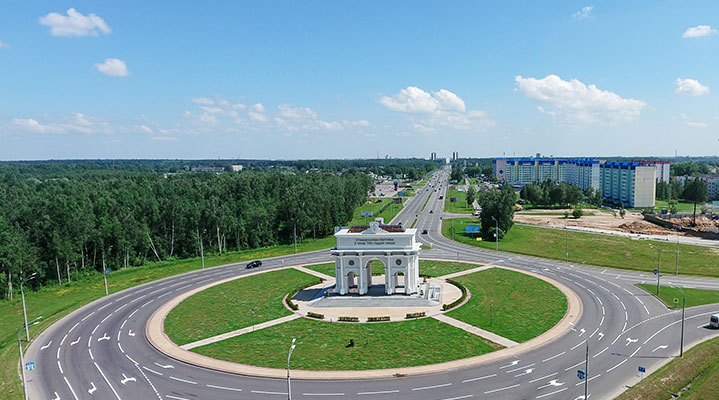 There is a 20-meter Triumphal Arch on the Minsk-Mogilev highway at the entrance to city. It was built using donations from residents to celebrate the outstanding natives of Mogilev. The arch is decorated with bas-reliefs of the region's highest awards - the Order of the Patriotic War Second Class and Lenin Order. At the base of the arch there is a capsule with a message to future generations calling them to love and protect their native city, to multiply its traditions. The arch was unveiled in October 2018.
There is a 20-meter Triumphal Arch on the Minsk-Mogilev highway at the entrance to city. It was built using donations from residents to celebrate the outstanding natives of Mogilev. The arch is decorated with bas-reliefs of the region's highest awards - the Order of the Patriotic War Second Class and Lenin Order. At the base of the arch there is a capsule with a message to future generations calling them to love and protect their native city, to multiply its traditions. The arch was unveiled in October 2018.
Arch of Glory (Memorial Arch)
The more famous arch of Mogilev is now located in the center of the city. It is not as big as the one at the entrance to the city or as the famous Arc de Triomphe in Paris, but it celebrates an important historical event. It was built in 1780 to impress high-profile guests. It was in Mogilev where Russian Empress Catherine II and Holy Roman Emperor Joseph II, the two powerful monarchs of Europe, met. These informal negotiations determined the fate of the Rzeczpospolita. The city authorities did their best to organize a solemn reception to please the demanding empress. The monarchs agreed to commemorate the event and to build temples - St. Joseph's Cathedral in Mogilev and St. Catherine's Cathedral in Vienna. The cathedral in Mogilev was eventually erected in front of the arch, but unfortunately it has not survived to this day. It was blown up in 1938. The arch itself was also subjected to alterations in the Soviet years. First, they built bas-reliefs - symbols of the USSR, and then, in the 1960s, a wall to close the passage under the arch to place commemorative plaques with the names of the fallen Red Army soldiers who liberated Mogilev from the Nazis.
Mogilev Town Hall
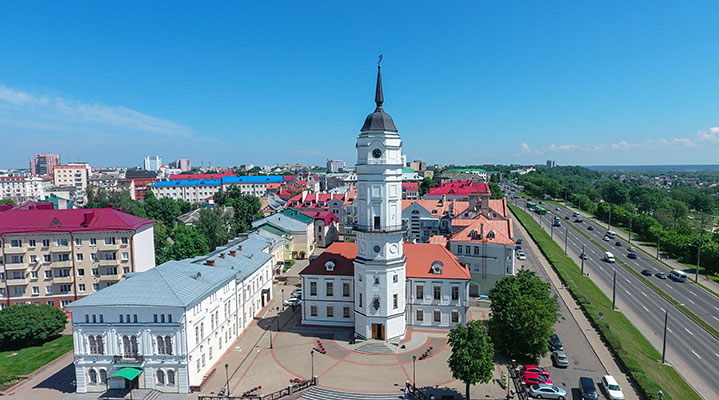 According to historical records, in 1526 Mogilev was granted town rights. In 1561 Sigismund II Augustus gave it basic privileges under the Magdeburg Law and the right to elect a voit (chief of the municipal administration). In 1577 the city got significant privileges under the Magdeburg Law from Stephen Bathory. The wooden building of the magistrate was destroyed by fire several times. A stone building to house the town hall was built on the central square called Trade Square in 1679. A distinctive feature of the building was a 46-meter octagonal tower. This town hall was destroyed and restored several times. The most recent restoration project dates back to 2008. It was rebuilt where it was originally erected (now this place is called Glory Square). Now the town hall is one of the calling cards of Mogilev. Centuries ago Catherine the Great and Holy Roman Emperor Joseph II climbed the tower of the town hall to enjoy a breathtaking view of the city. From here you can observe the Dnieper River, the Podnikolye Park and the entire city. The town hall features a tower clock and a mechanical figure of a bugler who was named Mogislav by local residents. Three times a day the boy makes a bugle call on the balcony: at 12:00, at 20:00 and at sunset.
According to historical records, in 1526 Mogilev was granted town rights. In 1561 Sigismund II Augustus gave it basic privileges under the Magdeburg Law and the right to elect a voit (chief of the municipal administration). In 1577 the city got significant privileges under the Magdeburg Law from Stephen Bathory. The wooden building of the magistrate was destroyed by fire several times. A stone building to house the town hall was built on the central square called Trade Square in 1679. A distinctive feature of the building was a 46-meter octagonal tower. This town hall was destroyed and restored several times. The most recent restoration project dates back to 2008. It was rebuilt where it was originally erected (now this place is called Glory Square). Now the town hall is one of the calling cards of Mogilev. Centuries ago Catherine the Great and Holy Roman Emperor Joseph II climbed the tower of the town hall to enjoy a breathtaking view of the city. From here you can observe the Dnieper River, the Podnikolye Park and the entire city. The town hall features a tower clock and a mechanical figure of a bugler who was named Mogislav by local residents. Three times a day the boy makes a bugle call on the balcony: at 12:00, at 20:00 and at sunset.
Palace of Archbishop Georgy Konissky
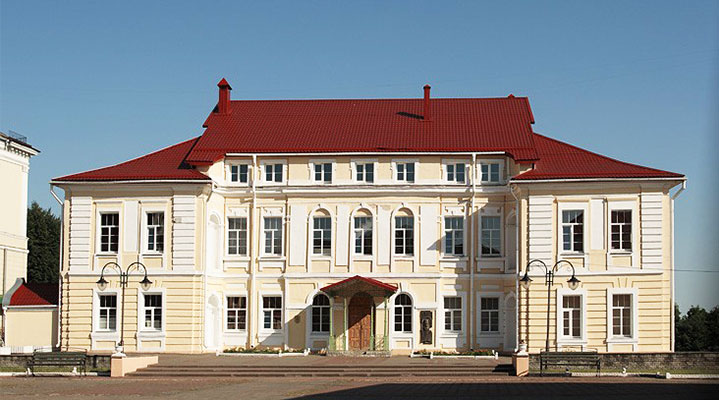 The Palace of Archbishop Georgy Konissky, a prominent Eastern Orthodox Church scholar and educator, Belarus’ saint, was erected by architect Johann Glaubitz in 1762-1785. The ancient residence remains one of the landmarks of Mogilev. Many of its elements such as niches, window cases with intricate patterns and floral motifs, give the palace Baroque-style looks. In the past there were monastic cells on both sides of the building; and the drawings on their walls made a complete ensemble of the whole compound. The large hall on the ground floor hosted receptions. The upper tier housed personal living quarters, an office and a library of the archbishop. Today the palace is known not only as an architectural specimen of the 18th century. It houses the Georgy Konissky Spiritual Education Center.
The Palace of Archbishop Georgy Konissky, a prominent Eastern Orthodox Church scholar and educator, Belarus’ saint, was erected by architect Johann Glaubitz in 1762-1785. The ancient residence remains one of the landmarks of Mogilev. Many of its elements such as niches, window cases with intricate patterns and floral motifs, give the palace Baroque-style looks. In the past there were monastic cells on both sides of the building; and the drawings on their walls made a complete ensemble of the whole compound. The large hall on the ground floor hosted receptions. The upper tier housed personal living quarters, an office and a library of the archbishop. Today the palace is known not only as an architectural specimen of the 18th century. It houses the Georgy Konissky Spiritual Education Center.
Mogilev Drama Theater
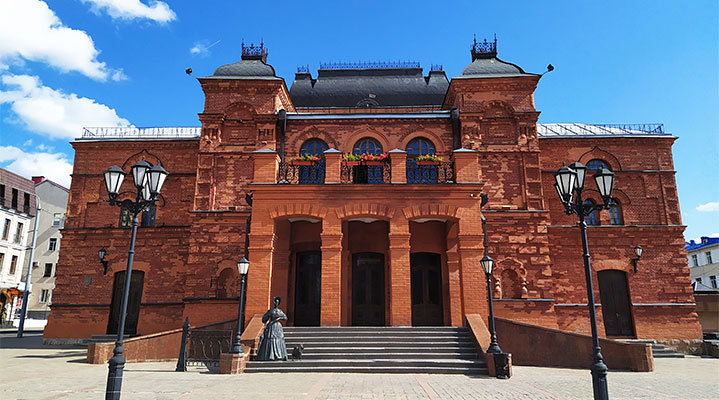 The original building of the Mogilev Drama Theater was the first in Belarus to be constructed specifically for a theater company. Before that performances were staged in the palaces of wealthy landlords and in pavilions of traveling theaters. Back in the 1810s local residents dreamed of a permanent theater, but their dream came true several decades later. The theater was designed by architect Piotr Kamburov. It was built from red brick in the pseudo-Russian style on the place of a 17th-century castle. The theater was solemnly inaugurated on 25 September 1888. It boasted one of Europe’s best stages in terms of sound. Among the celebrated artists who performed at the theater were opera singer Feodor Chaliapin, virtuoso Sergei Rachmaninoff, and actress Vera Komissarzhevskaya. It was there that Emperor Nicholas II watched wartime newsreel and reviewed the troops during the First World War from the balcony.
The original building of the Mogilev Drama Theater was the first in Belarus to be constructed specifically for a theater company. Before that performances were staged in the palaces of wealthy landlords and in pavilions of traveling theaters. Back in the 1810s local residents dreamed of a permanent theater, but their dream came true several decades later. The theater was designed by architect Piotr Kamburov. It was built from red brick in the pseudo-Russian style on the place of a 17th-century castle. The theater was solemnly inaugurated on 25 September 1888. It boasted one of Europe’s best stages in terms of sound. Among the celebrated artists who performed at the theater were opera singer Feodor Chaliapin, virtuoso Sergei Rachmaninoff, and actress Vera Komissarzhevskaya. It was there that Emperor Nicholas II watched wartime newsreel and reviewed the troops during the First World War from the balcony.
At the entrance to the theater there is a bronze statue Lady with a Dog, a copy of the famous sculpture by Belarusian sculptor Vladimir Zhbanov that can be seen on the Komarovka Market in Minsk.
Pedestrian Lenin Street
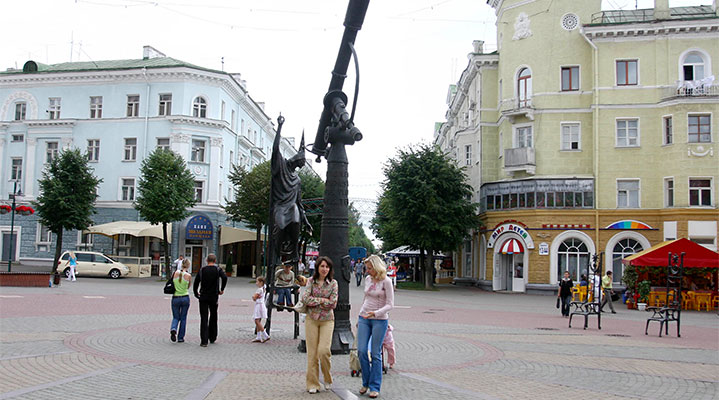 The air of history can be felt in the pedestrian Lenin Street that has been known since the 16th century under various names, like Vetryanaya Street, Bolshaya Sadovaya Street and Inzhenernaya Street. Here one can see beautiful buildings dating back to the 18th-19th centuries: the former municipal administration building, the palace of the archbishop, the gymnasium which famous students included the First Hawaii Senate President Nikolai Sudzilovsky and a celebrated explorer of the Arctic Otto Schmidt… Visitors are also impressed by architectural specimens of the early 20th century, like the building of the Main Directorate of the National Bank erected in the Eclectic style in 1904-1906.
The air of history can be felt in the pedestrian Lenin Street that has been known since the 16th century under various names, like Vetryanaya Street, Bolshaya Sadovaya Street and Inzhenernaya Street. Here one can see beautiful buildings dating back to the 18th-19th centuries: the former municipal administration building, the palace of the archbishop, the gymnasium which famous students included the First Hawaii Senate President Nikolai Sudzilovsky and a celebrated explorer of the Arctic Otto Schmidt… Visitors are also impressed by architectural specimens of the early 20th century, like the building of the Main Directorate of the National Bank erected in the Eclectic style in 1904-1906.
The Square of Stars is located in the center of the street. The square features the world’s only monument to the stargazer and the sundial consisting of 12 chairs symbolizing the Zodiac signs. They were designed by famous Belarusian sculptor Vladimir Zhbanov. During holidays a laser in the stargazer’s telescope starts projecting a ray that is seen high above.
Vitold Belynitsky-Birulya Art Museum
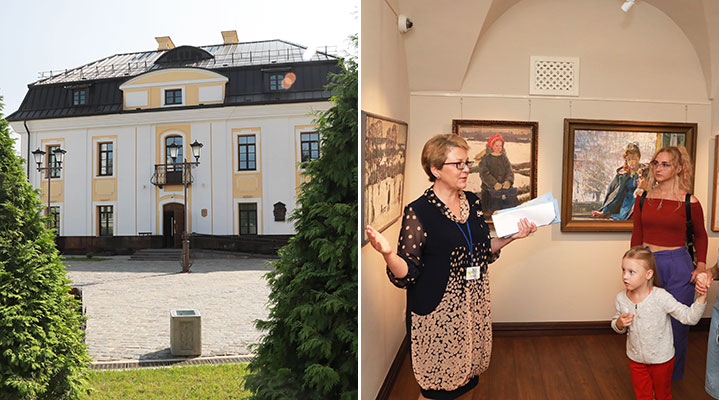 The museum of outstanding Belarusian landscape painter Vitold Belynitsky-Birulya, a native of Mogilev Oblast, is a subsidiary of the National Art Museum of Belarus. The painter did not live here, but the building is of great architectural value. It was erected in the Baroque style in the 17th century. The building belonged to a wealthy family of merchants. It was the best two-storey stone estate in the town, therefore it was there where Holy Roman Emperor Joseph II stayed in May 1780. In 1815-1917 it housed the Mogilev Gentry Assembly. In the 20th century the house became the country’s first memorial museum dedicated to the artist. The works by Vitold Belynitsky-Birulya delighted art lovers in Belarus and abroad and were acknowledged by prestigious international awards. The museum’s holdings include documents, photos of the artist and his family, the artist’s personal belongings: the painting box, the palette, brushes, the sporting gun… The museum keeps the medal received for the famous Winter Dream at the exhibition in Barcelona (1911). There is also a cycle of paintings dedicated to Pushkin places: "Mikhailovskoye. House of Alexander Pushkin’s nurse Arina Rodionovna", "Svyatogorsk Monastery. Alexander Pushkin’s Tomb", "Trigorskoye. A birch by the Sorot River" …
The museum of outstanding Belarusian landscape painter Vitold Belynitsky-Birulya, a native of Mogilev Oblast, is a subsidiary of the National Art Museum of Belarus. The painter did not live here, but the building is of great architectural value. It was erected in the Baroque style in the 17th century. The building belonged to a wealthy family of merchants. It was the best two-storey stone estate in the town, therefore it was there where Holy Roman Emperor Joseph II stayed in May 1780. In 1815-1917 it housed the Mogilev Gentry Assembly. In the 20th century the house became the country’s first memorial museum dedicated to the artist. The works by Vitold Belynitsky-Birulya delighted art lovers in Belarus and abroad and were acknowledged by prestigious international awards. The museum’s holdings include documents, photos of the artist and his family, the artist’s personal belongings: the painting box, the palette, brushes, the sporting gun… The museum keeps the medal received for the famous Winter Dream at the exhibition in Barcelona (1911). There is also a cycle of paintings dedicated to Pushkin places: "Mikhailovskoye. House of Alexander Pushkin’s nurse Arina Rodionovna", "Svyatogorsk Monastery. Alexander Pushkin’s Tomb", "Trigorskoye. A birch by the Sorot River" …
Pavel Maslenikov Mogilev Regional Art Museum
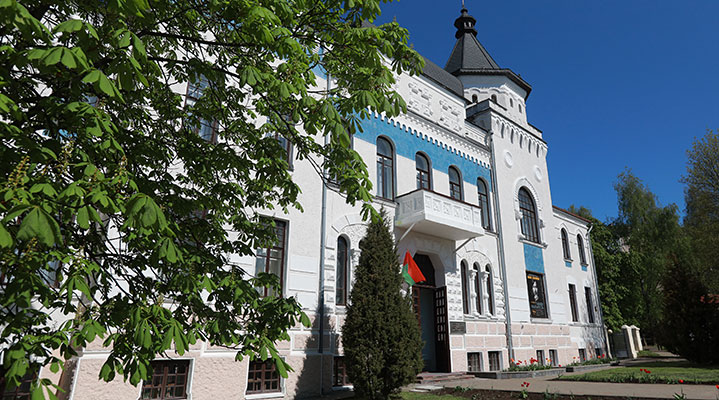 Another art museum of Mogilev is not just a treasury of artworks of the 17th-19th centuries but also a great specimen of architecture. The building of a farmers’ land bank, which once housed museums, institutions, newspaper offices, was built in 1903-1914. The design unites harmoniously Modern, the Russian Revival style and Late Classicism. The main attraction of the museum was the armored safe room, where unique valuables were kept, many of which were lost during the Great Patriotic War. Among them was the Cross of Euphrosyne of Polotsk (now the museum has an exposition with a hologram of a relic), the gold of Pompeii, a tray of Alexander the Great, paintings by European artists, handwritten books and letters of commendation, coins and icons of the 17th-19th centuries. By the way, the museum can be seen not only during a walk around Mogilev, but also on the Belarusian money – a Br200 banknote.
Another art museum of Mogilev is not just a treasury of artworks of the 17th-19th centuries but also a great specimen of architecture. The building of a farmers’ land bank, which once housed museums, institutions, newspaper offices, was built in 1903-1914. The design unites harmoniously Modern, the Russian Revival style and Late Classicism. The main attraction of the museum was the armored safe room, where unique valuables were kept, many of which were lost during the Great Patriotic War. Among them was the Cross of Euphrosyne of Polotsk (now the museum has an exposition with a hologram of a relic), the gold of Pompeii, a tray of Alexander the Great, paintings by European artists, handwritten books and letters of commendation, coins and icons of the 17th-19th centuries. By the way, the museum can be seen not only during a walk around Mogilev, but also on the Belarusian money – a Br200 banknote.
Three Saints Cathedral
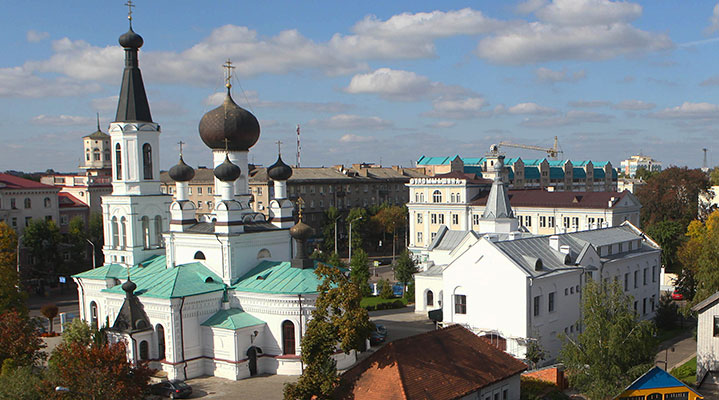 The city’s main Orthodox church, an architectural specimen of the early 20th century was named after holy hierarchs - Basil the Great, Gregory the Theologian, and John Chrysostom. The seven-dome cross-shaped cathedral was built in the Russian Revival style. It has a very remarkable feature: one can enter it from three sides. During the First World War the cathedral was frequented by Emperor Nicholas II. The major halidom of the church is the replica of the wonder-working Icon of the Mother of God of Mogilev and Bratsk. The church also keeps the icon of Saint Nicholas with pieces of hallows, the replicas of the Belynichi and Barkolabovo icons of the Mother of God, and the image of Saint Euphrosyne of Polotsk dating back to 1910.
The city’s main Orthodox church, an architectural specimen of the early 20th century was named after holy hierarchs - Basil the Great, Gregory the Theologian, and John Chrysostom. The seven-dome cross-shaped cathedral was built in the Russian Revival style. It has a very remarkable feature: one can enter it from three sides. During the First World War the cathedral was frequented by Emperor Nicholas II. The major halidom of the church is the replica of the wonder-working Icon of the Mother of God of Mogilev and Bratsk. The church also keeps the icon of Saint Nicholas with pieces of hallows, the replicas of the Belynichi and Barkolabovo icons of the Mother of God, and the image of Saint Euphrosyne of Polotsk dating back to 1910.
Cathedral of the Assumption of the Blessed Virgin and St. Stanislaus
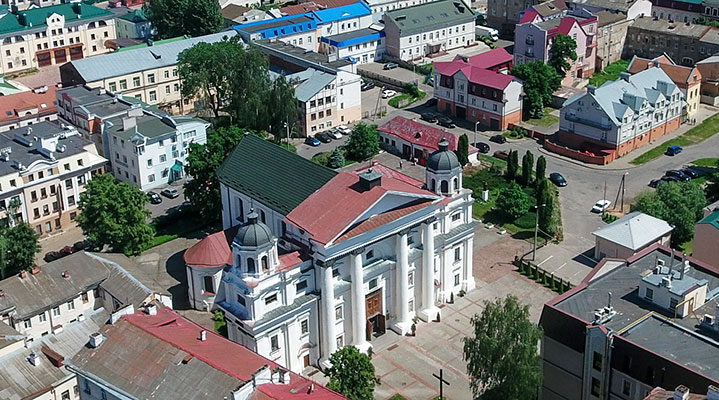 A wonderful Baroque Roman-Catholic church of the Assumption of the Blessed Virgin was built in Mogilev in 1738-1752 at the site of the monastery of the Carmelites. According to legends, it was built from oven bricks that townspeople brought to expiate their guilt for the murder of a local nobleman. After visiting the temple in 1780, Empress Catherine II ordered to evict the monks, and to transform the church into a cathedral church. At the end of the 18th century it was reconstructed in the Classicism style and got the second name - in honor of St. Stanislaus.
A wonderful Baroque Roman-Catholic church of the Assumption of the Blessed Virgin was built in Mogilev in 1738-1752 at the site of the monastery of the Carmelites. According to legends, it was built from oven bricks that townspeople brought to expiate their guilt for the murder of a local nobleman. After visiting the temple in 1780, Empress Catherine II ordered to evict the monks, and to transform the church into a cathedral church. At the end of the 18th century it was reconstructed in the Classicism style and got the second name - in honor of St. Stanislaus.
The pride of the church is the authentic frescoes of the second half of the 18th century, made by different painters on biblical subjects. This is one of the most complete and professional evangelical cycles in Belarus. Unfortunately, the unique organ was destroyed, which, according to the legend, was numbered in the Vatican under number 2. Today, the church hosts concerts of the international festival of church music Magutny Bozha (Mighty God) on a yearly basis.
St. Nicholas Monastery
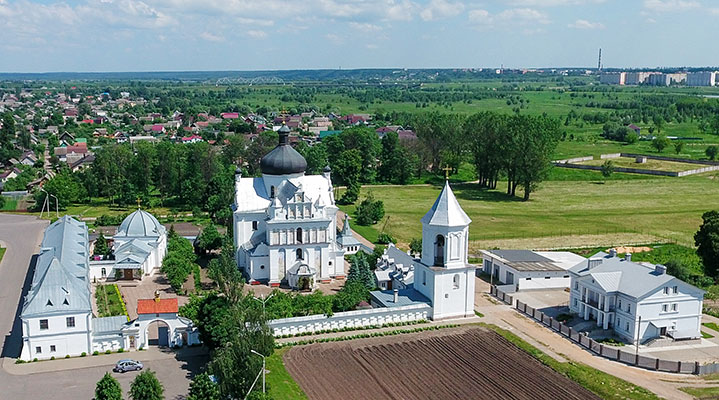 The history of the monastery is connected with the construction of a church in honor of St. Nicholas the Wonderworker in Mogilev. The first mention of the church dates back to 1522. Chronicles say that the wooden church was rebuilt many times, was looted more than once, and, unfortunately, did not survive a large fire. A stone monastery was built in the middle of the 17th century in a picturesque place near the Dnieper.
The history of the monastery is connected with the construction of a church in honor of St. Nicholas the Wonderworker in Mogilev. The first mention of the church dates back to 1522. Chronicles say that the wooden church was rebuilt many times, was looted more than once, and, unfortunately, did not survive a large fire. A stone monastery was built in the middle of the 17th century in a picturesque place near the Dnieper.
Today St. Nicholas Monastery is one of the few surviving buildings in the Belarusian Baroque style. It unites St. Nicholas Cathedral built in 1669-1672 (included in the UNESCO list of the most valuable Baroque buildings in Europe), the Temple of St. Onuphrius the Great, a belfry, a vault and living quarters. The pride of St. Nicholas Church is a beautiful four-tier iconostasis made by skilled Mogilev carvers in the 17th century, among whom was Klim Mikhailov, a native of Shklov. He is famous for his work on the Tsar Palace in Kolomenskoye and on the chambers of the Kremlin. Similar iconostasis can be seen only in the Smolensk Cathedral of the Novodevichy Convent in Moscow.
St. Nicholas Church was attended by Russian Emperor Nicholas II. Earlier, False Dmitry II was a novice at the church.
Podnikolye Park
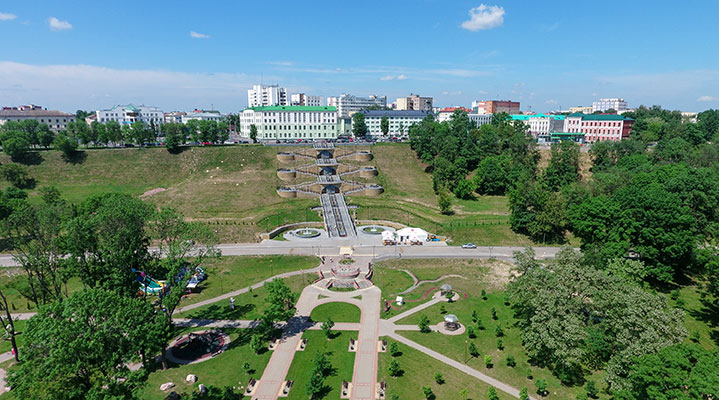 Podnikolye Park was laid out not long ago, although the Dnieper bank near St. Nicholas Monastery has always been one of the most picturesque sites in the city. A large landscape and recreational complex was founded here in 2014. The park features pedestrian and bicycle lanes, arbours, benches, children's play grounds and many more. Plans are in place to add a syringarium, a rope town, an indoor ice rink, an amphitheater, a miniature park, a restaurant of national cuisine, a tourist center, a hinged bridge in Zadneprovye. The park has quickly become a popular place with residents and guests of Mogilev, a venue of various festivals. The main draw of the park and one of the most photographed attractions of the city is a staircase with a cascade of fountains, which descends from Ordzhonikidze Square and Karl Marx Street to Bolshaya Grazhdanskaya Street in Podnikolye. Its height is approximately equal to a seven-storey house.
Podnikolye Park was laid out not long ago, although the Dnieper bank near St. Nicholas Monastery has always been one of the most picturesque sites in the city. A large landscape and recreational complex was founded here in 2014. The park features pedestrian and bicycle lanes, arbours, benches, children's play grounds and many more. Plans are in place to add a syringarium, a rope town, an indoor ice rink, an amphitheater, a miniature park, a restaurant of national cuisine, a tourist center, a hinged bridge in Zadneprovye. The park has quickly become a popular place with residents and guests of Mogilev, a venue of various festivals. The main draw of the park and one of the most photographed attractions of the city is a staircase with a cascade of fountains, which descends from Ordzhonikidze Square and Karl Marx Street to Bolshaya Grazhdanskaya Street in Podnikolye. Its height is approximately equal to a seven-storey house.
Lenina Square and House of Soviets
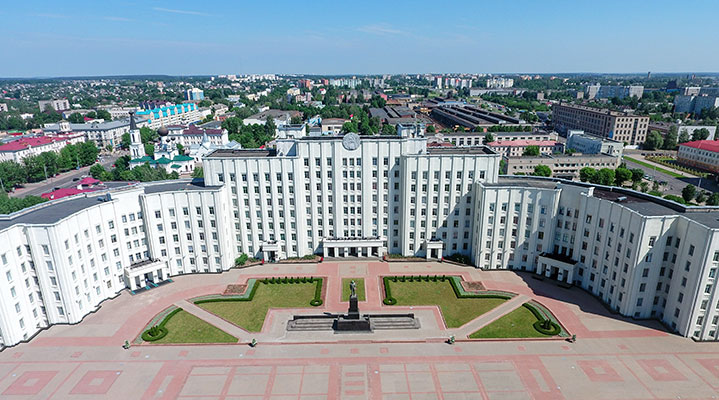 Lenina Square is the center of modern Mogilev. Before the Great October Revolution it was the outskirts of the city, where a hay market, barracks and prisons were located. Before the Second World War, Minsk was too close to the western border of the country and there was a threat of attack. The government decided to move the capital to Mogilev. In record time, from 1937 to 1939, large-scale buildings were built in Mogilev to correspond to the status of the main city of the country. A virtually exact replica of the House of Government in Minsk dominates the new square at the crossroads of Pervomaiskaya Street (the central street of Mogilev in the distant past) and the new Mira Avenue. The replica was built to the design of the famous architect Iosif Langbard. Nevertheless, the situation changed after Western Belarus and the BSSR re-united: Minsk remained the capital city while Mogilev got an impulse that spurred future development. The large square in the Constructivism style still serves as a reminder of that unusual page in history. The Mogilev Oblast Executive Committee (the Mogilev Oblast administration) works in the House of Councils now. On the southern side of the square there is another monumental building of the Soviet era: it housed a headquarters of the NKVD till 1961, Mogilev Machine Building Institute later on, and Belarusian-Russian University at present.
Lenina Square is the center of modern Mogilev. Before the Great October Revolution it was the outskirts of the city, where a hay market, barracks and prisons were located. Before the Second World War, Minsk was too close to the western border of the country and there was a threat of attack. The government decided to move the capital to Mogilev. In record time, from 1937 to 1939, large-scale buildings were built in Mogilev to correspond to the status of the main city of the country. A virtually exact replica of the House of Government in Minsk dominates the new square at the crossroads of Pervomaiskaya Street (the central street of Mogilev in the distant past) and the new Mira Avenue. The replica was built to the design of the famous architect Iosif Langbard. Nevertheless, the situation changed after Western Belarus and the BSSR re-united: Minsk remained the capital city while Mogilev got an impulse that spurred future development. The large square in the Constructivism style still serves as a reminder of that unusual page in history. The Mogilev Oblast Executive Committee (the Mogilev Oblast administration) works in the House of Councils now. On the southern side of the square there is another monumental building of the Soviet era: it housed a headquarters of the NKVD till 1961, Mogilev Machine Building Institute later on, and Belarusian-Russian University at present.
Buinichi Field memorial complex
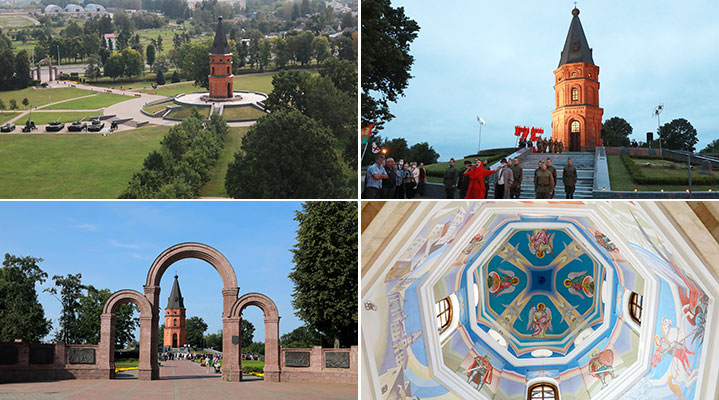 The Buinichi Field memorial was created on the outskirts of Mogilev, near the village of Buinichi, in the location where defenders of the city fell in the first days of the Great Patriotic War of 1941-1945. The memorial was opened on 9 May 1995. It became a historical and cultural value of Belarus in 2002. It impresses every visitor! Mogilev is rightfully called “the father of Stalingrad”. When the country was still mobilizing in July 1941, regular army units and militia defended the place for 23 days, setting an example of unbelievable valor. A memorial complex was erected in honor of their heroic feat. There is a chapel made of red bricks in the style of Orthodox Christian architecture in the center of the complex. Hundreds of names of those who fell to defend Mogilev were inscribed on commemorative tablets inside the chapel. A Foucault pendulum is attached to the dome as a symbol of eternal memory about the defenders. Under the chapel there is a crypt where remains of the soldiers found on battlefields outside Mogilev are solemnly reburied these days. Four alleys diverge from the commemorative chapel. One of them is dedicated to the first “chronicler” of the defense of Mogilev – Konstantin Simonov, a reporter and writer, the author of the novel The Living And The Dead. He worked as an army reporter near Mogilev in July 1941 and saw the bloodbath with his own eyes. He “returned” here in 1979 when his ashes were scattered upon the Buinichi Field according to his will. The Lake of Tears that represents sorrow of all the mothers whose kids perished during the war is located not far from the chapel… Apart from that, a collection of military hardware that anyone can examine can be found in the memorial complex.
The Buinichi Field memorial was created on the outskirts of Mogilev, near the village of Buinichi, in the location where defenders of the city fell in the first days of the Great Patriotic War of 1941-1945. The memorial was opened on 9 May 1995. It became a historical and cultural value of Belarus in 2002. It impresses every visitor! Mogilev is rightfully called “the father of Stalingrad”. When the country was still mobilizing in July 1941, regular army units and militia defended the place for 23 days, setting an example of unbelievable valor. A memorial complex was erected in honor of their heroic feat. There is a chapel made of red bricks in the style of Orthodox Christian architecture in the center of the complex. Hundreds of names of those who fell to defend Mogilev were inscribed on commemorative tablets inside the chapel. A Foucault pendulum is attached to the dome as a symbol of eternal memory about the defenders. Under the chapel there is a crypt where remains of the soldiers found on battlefields outside Mogilev are solemnly reburied these days. Four alleys diverge from the commemorative chapel. One of them is dedicated to the first “chronicler” of the defense of Mogilev – Konstantin Simonov, a reporter and writer, the author of the novel The Living And The Dead. He worked as an army reporter near Mogilev in July 1941 and saw the bloodbath with his own eyes. He “returned” here in 1979 when his ashes were scattered upon the Buinichi Field according to his will. The Lake of Tears that represents sorrow of all the mothers whose kids perished during the war is located not far from the chapel… Apart from that, a collection of military hardware that anyone can examine can be found in the memorial complex.
Outdoor military museum
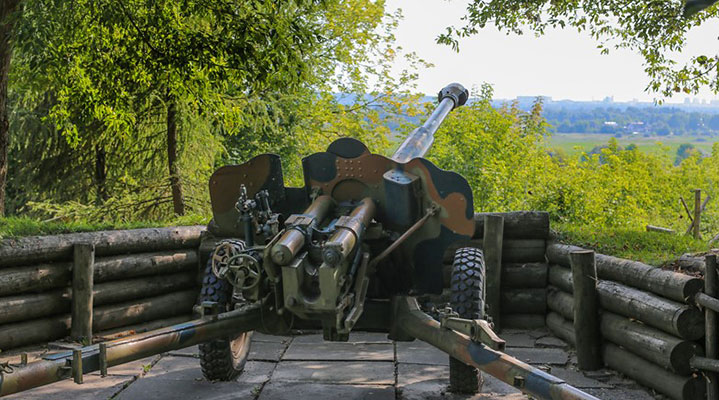 Opposite to the Buinichi Field memorial complex, there is another unique place for those who are interested in the history of World War Two. An outdoor military museum was created in Buinichi upon the initiative of students and professors of Mogilev State Professional Agroforestry College. The museum tells the story of the heroic events that happened across the road from the Buinichi Field in the course of Belarus’ liberation. Strong German defenses were erected on a foothold 40 meters above the Dnieper River where the college is located now. On 27 June 1944 the Red Army units led by Senior Lieutenant Ivan Melnov crossed the river in the face of machine gun fire, climbed the steep hill, and cleared the enemy’s positions… 70 years later it was decided to recreate the defense line there as precisely as possible by relying on archive documents and recollections of witnesses of events of that war. The museum originated with a German fortified emplacement, which remained since the time of World War Two. The number of exhibits grows larger every year. For instance, the second genuine German fortified emplacement made of reinforced concrete and weighing about 45 tonnes was brought to the museum from Bykhov District. The museum’s collection now includes weapons and vehicles, restored trenches, a dugout, a trench shelter, an observation tower…
Opposite to the Buinichi Field memorial complex, there is another unique place for those who are interested in the history of World War Two. An outdoor military museum was created in Buinichi upon the initiative of students and professors of Mogilev State Professional Agroforestry College. The museum tells the story of the heroic events that happened across the road from the Buinichi Field in the course of Belarus’ liberation. Strong German defenses were erected on a foothold 40 meters above the Dnieper River where the college is located now. On 27 June 1944 the Red Army units led by Senior Lieutenant Ivan Melnov crossed the river in the face of machine gun fire, climbed the steep hill, and cleared the enemy’s positions… 70 years later it was decided to recreate the defense line there as precisely as possible by relying on archive documents and recollections of witnesses of events of that war. The museum originated with a German fortified emplacement, which remained since the time of World War Two. The number of exhibits grows larger every year. For instance, the second genuine German fortified emplacement made of reinforced concrete and weighing about 45 tonnes was brought to the museum from Bykhov District. The museum’s collection now includes weapons and vehicles, restored trenches, a dugout, a trench shelter, an observation tower…
Mogilev Zoological Garden
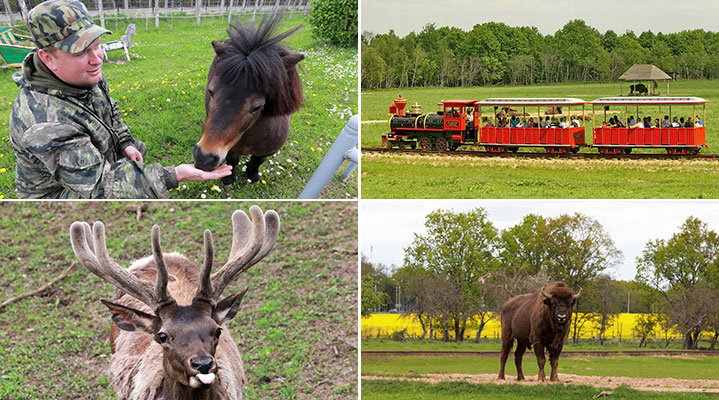 The zoological garden is another project, launched in the early 2000s under the auspices of the local agroforestry college. It started out as a college lab and became one of the most popular attractions in Mogilev. The zoological garden occupies 150 hectares along the Dnieper River. Animals are kept in a cozy “living zone” that occupies 30 hectares. The garden is home to 20 species of animals whose number approximates 350 in total. Every “home” is as comfortable as possible. The rest of the territory – about 120 hectares – is an area where aurochs, deer, fallow deer, and mouflons can freely graze… Visitors can see the animals and appreciate the surrounding area by taking a Safari on Railroad tour. Along the 2km-long road visitors can also see a branched system of canyons that formed back in the Ice Age.
The zoological garden is another project, launched in the early 2000s under the auspices of the local agroforestry college. It started out as a college lab and became one of the most popular attractions in Mogilev. The zoological garden occupies 150 hectares along the Dnieper River. Animals are kept in a cozy “living zone” that occupies 30 hectares. The garden is home to 20 species of animals whose number approximates 350 in total. Every “home” is as comfortable as possible. The rest of the territory – about 120 hectares – is an area where aurochs, deer, fallow deer, and mouflons can freely graze… Visitors can see the animals and appreciate the surrounding area by taking a Safari on Railroad tour. Along the 2km-long road visitors can also see a branched system of canyons that formed back in the Ice Age.
Belarusian Village of the 21st Century tourism and ethnography complex
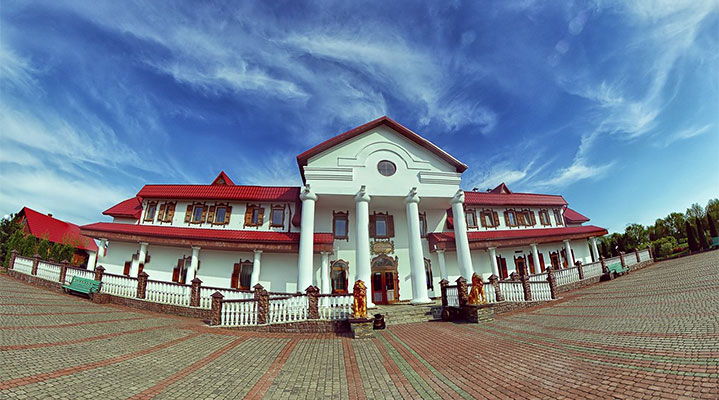 A tourism complex and an open-air museum styled to look like a Belarusian village are located next to the zoological garden. As visitors walk along the streets, they can easily imagine how rural dwellers lived in Mogilev lands back in the 19th century. There is a windmill in the village as well as workshops of a weaver, a carpenter, a blacksmith, a baker, a potter and even a moonshiner. Each is ready to share their secrets with visitors. There is a cafe and a hotel in the landlord’s house. The nearby restaurant Korchma offers Belarusian cuisine dishes and authentic beverages.
A tourism complex and an open-air museum styled to look like a Belarusian village are located next to the zoological garden. As visitors walk along the streets, they can easily imagine how rural dwellers lived in Mogilev lands back in the 19th century. There is a windmill in the village as well as workshops of a weaver, a carpenter, a blacksmith, a baker, a potter and even a moonshiner. Each is ready to share their secrets with visitors. There is a cafe and a hotel in the landlord’s house. The nearby restaurant Korchma offers Belarusian cuisine dishes and authentic beverages.


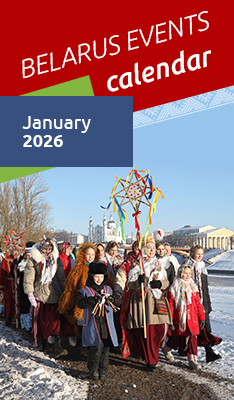




 print version
print version make home page
make home page add to bookmarks
add to bookmarks
